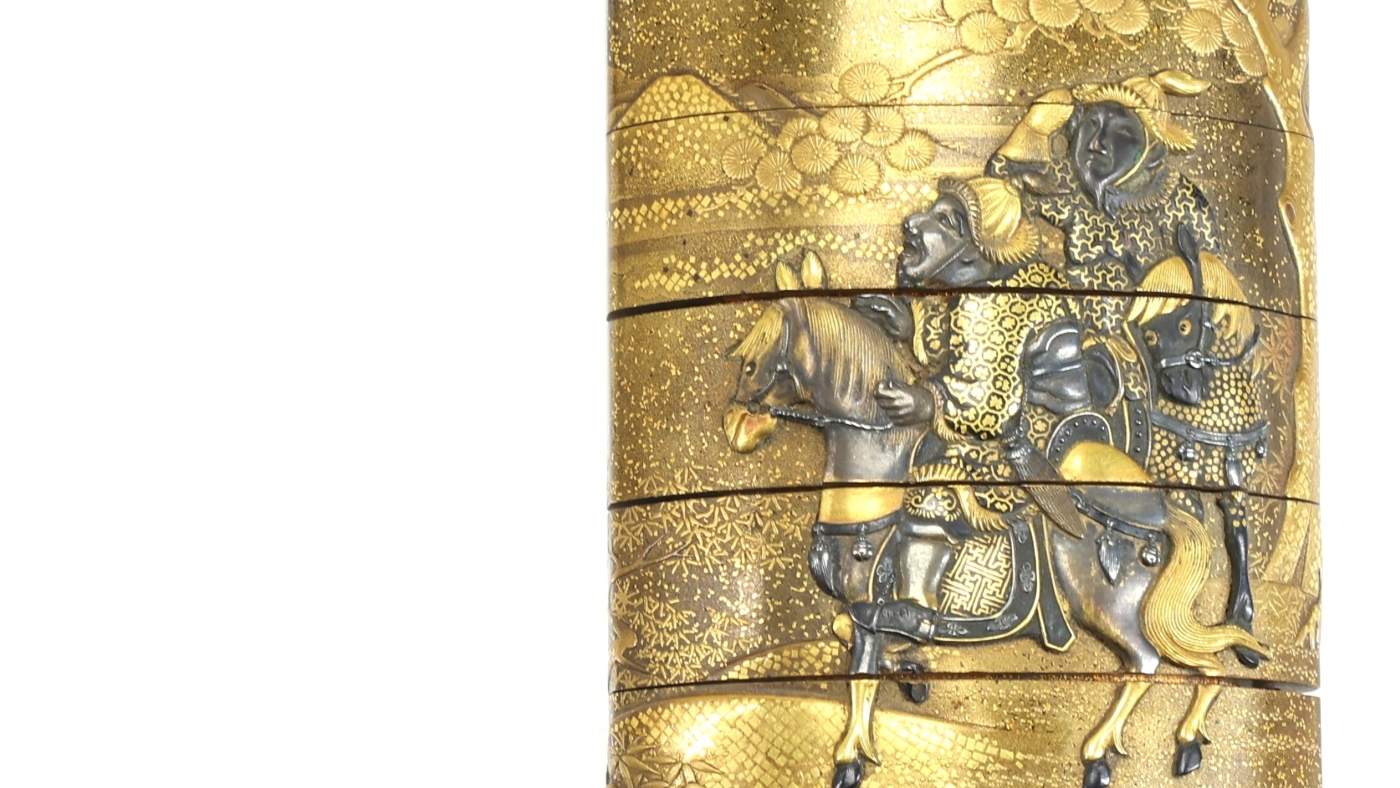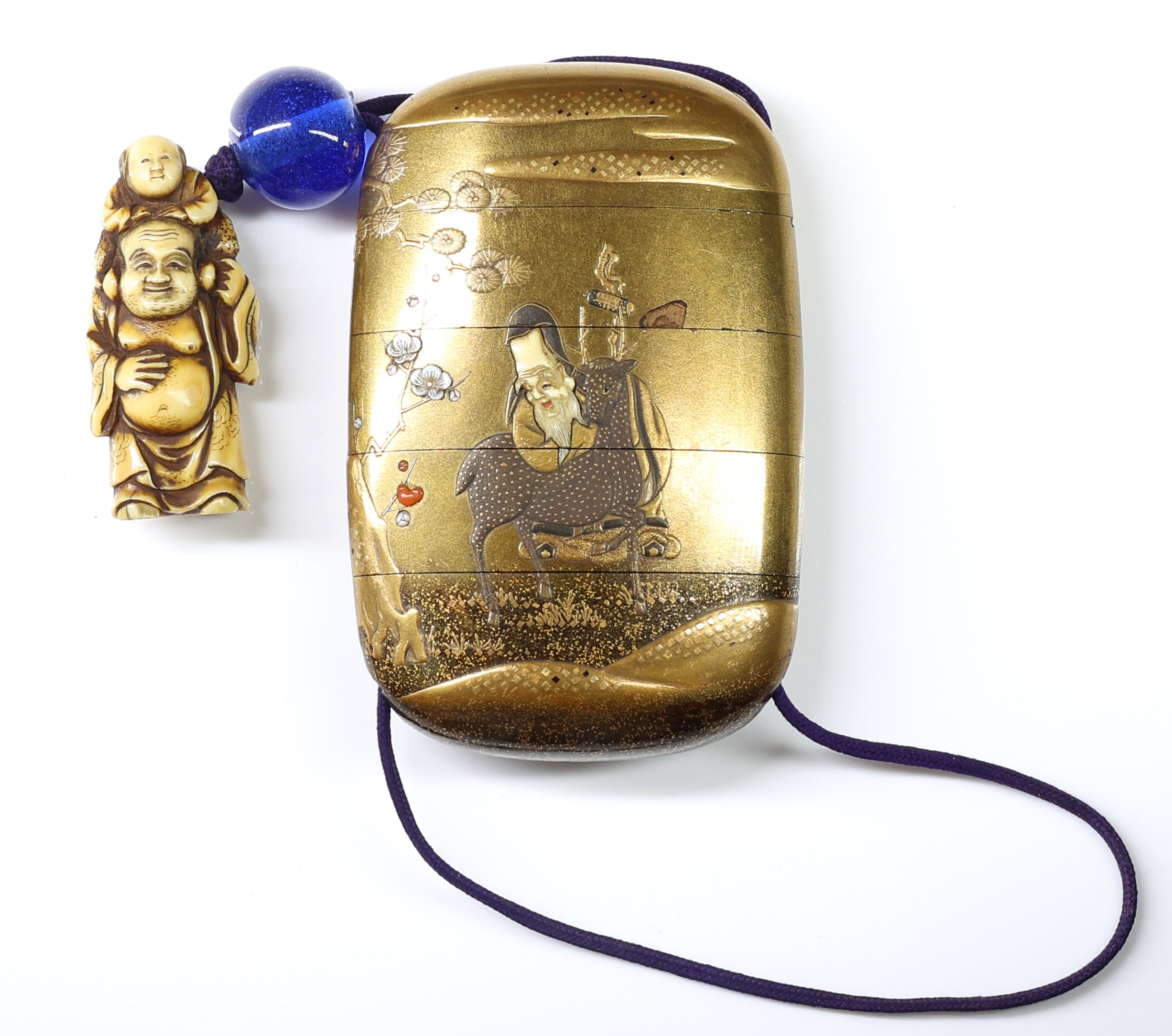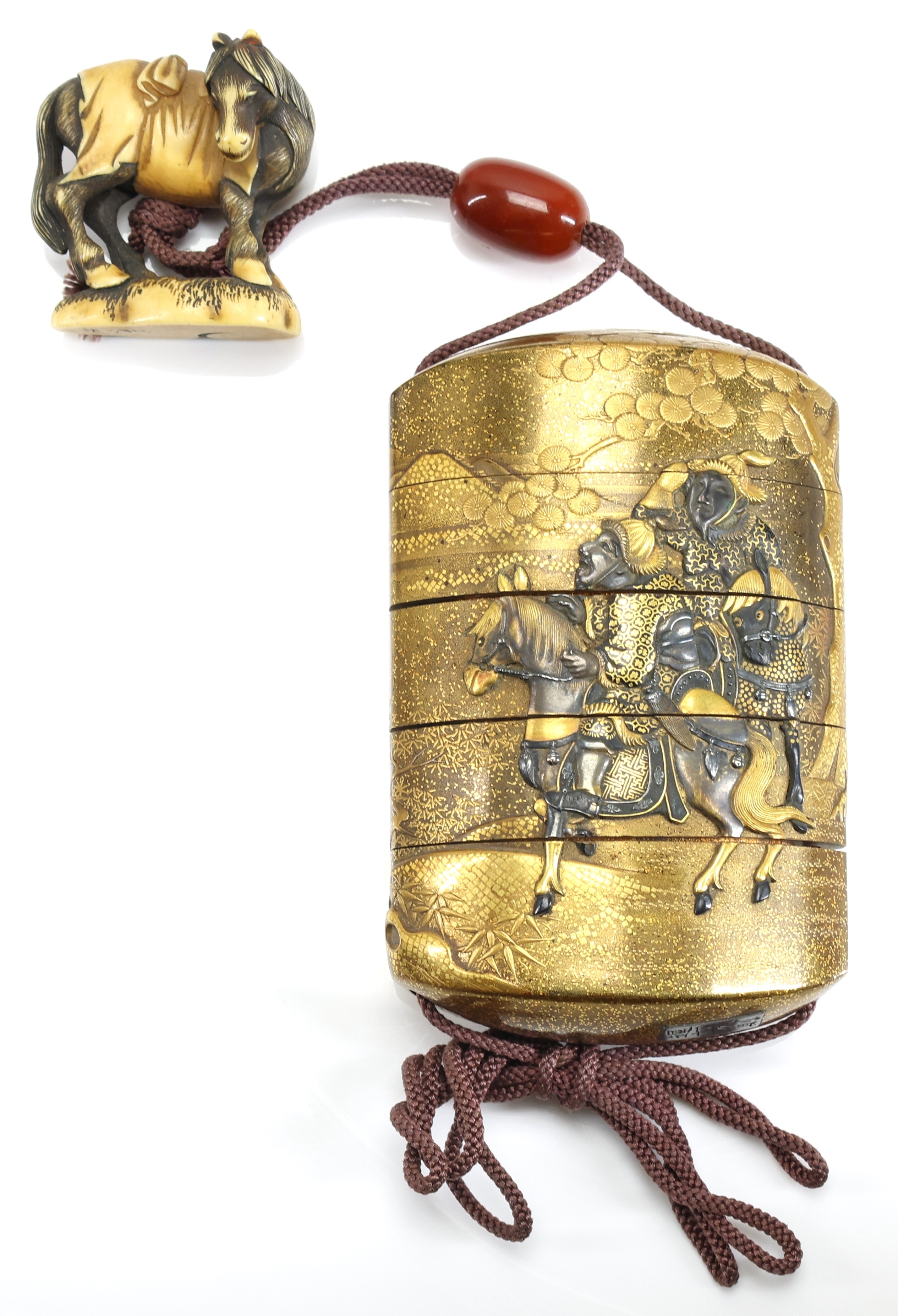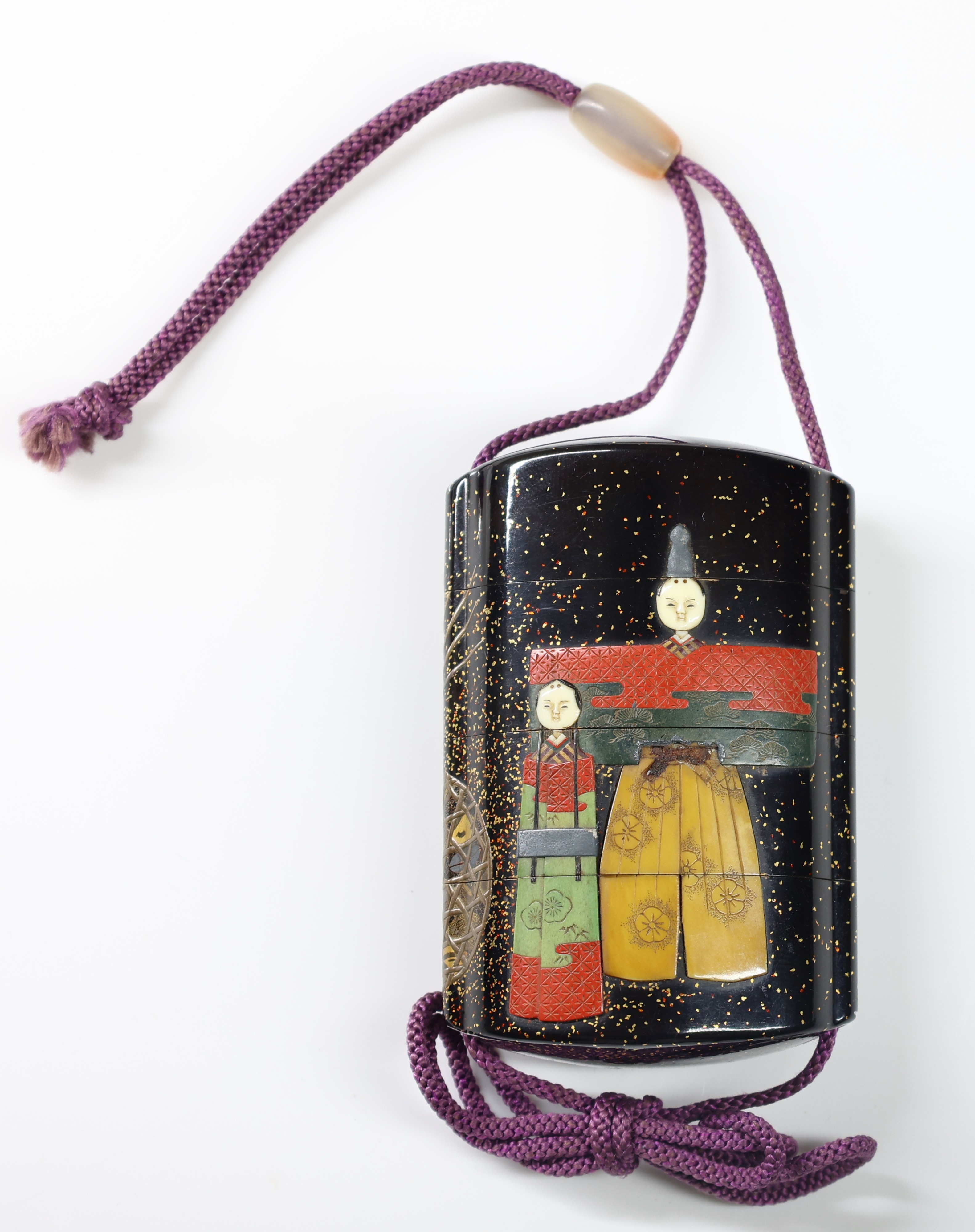From Samurai Utility to Collectors’ Treasure: The Story of the Inro

From Samurai Utility to Collectors’ Treasure: The Story of the Inro
Written by: Christian Answini and Adrian Martinez | Fine Art Department
From Samurai Utility to Collectors’ Treasure: The Story of the Inro
Among the highlights of the Galloway and Sandra Morris Estate Auction on November 6th, a series of finely crafted Japanese inro boxes reveal how the smallest objects can embody centuries of cultural evolution. Once a practical accessory in the daily life of samurai and scholars, the inro has become a coveted collectible—admired for its technical brilliance, narrative imagery, and deep connection to Japanese art traditions.
What Is an Inro?
The inro (印籠), literally “seal basket,” originated in the late 16th century as a compact, tiered container suspended from a man’s sash. Traditional Japanese garments such as the kimono lacked pockets, so men carried small essentials—seals, medicine, or herbs—in inro that hung from a cord and were secured by an ojime bead and netsuke toggle.
Over time, these utilitarian cases evolved into miniature showcases of craftsmanship, blending the disciplines of lacquerware, metalwork, carving, and painting. Each compartment fit precisely into the next, and the surface became a canvas for artisans to explore themes from literature, mythology, and nature. The finest examples were produced during the Edo period (1603–1868) and signed by artists whose reputations rivaled painters and poets of their day.
The Artistry of Lacquer and Symbolism
Lacquer, derived from the sap of the urushi tree, offered a durable yet luminous surface that could be built up in layers and dusted with gold or silver powder—a process known as maki-e. Some masters added inlays of mother-of-pearl (raden), metals, or ivory, creating textural contrasts and narrative depth. The motifs were far from decorative alone; they conveyed stories of loyalty, seasonal beauty, and moral lessons drawn from classic Japanese literature and folklore. In the Morris Estate collection, this balance of artistry and storytelling is on full display. Each inro not only captures technical mastery but also reflects the cultural refinement that defined Japan’s Edo society.
The Kajikawa Lineage Inro: Gold, Power, and Poise
One of the finest examples from the auction is a Kajikawa Lineage Japanese Lacquer Inro, an opulent piece that gleams with gold ground and raised decoration. The Kajikawa family name is synonymous with excellence in maki-e lacquer; generations of artisans working under this lineage produced lacquerware for the Edo shogunate from the seventeenth century onward. Their works are characterized by a remarkably consistent technique and style, making them difficult to date precisely. Most Kajikawa inro carry a gold lacquer signature “Kajikawa saku” followed by a red lacquer vase-shaped seal, though several variations of the signature exist. This example depicts an equestrian scene on one side, with an eagle in flight over a waterfall on the other, rendered in fine relief and highlighted with gold and silver tones. The workmanship is typical of late-Edo refinement, blending realism with stylized patterning. A carved ivory netsuke of a horse and a red agate ojime complete the ensemble, creating a visual harmony that underscores both the martial and aesthetic ideals of the samurai class. What was once a functional container becomes a statement of rank and discernment—a wearable emblem of culture and discipline.
Toyo after Hakugyoku: Portraits of Courtly Elegance
Equally striking is the Toyo after Hakugyoku Japanese Lacquer Inro, its polished black surface enlivened with brilliantly colored figures of a noble couple. Here, the artisan blends pigment and inlay to portray the Heian-period court, a setting long romanticized in Japanese art. The male and female figures, dressed in layered brocade robes, suggest ideals of grace and harmony that were central to classical poetry and painting. The background, speckled with gold flecks, evokes a starry night or falling blossoms—a poetic metaphor for transience and beauty. This inro exemplifies the Edo fascination with historical nostalgia, a reminder that by the 18th and 19th centuries, artists were not only chronicling the present but also reviving Japan’s aristocratic past through the lens of lacquer.
Toyo was a lacquer master whose school and works have been extensively studied through analysis of kakihan—the cursive monograms used by Japanese artists as personal signatures. Scholarly research has identified twenty-six distinct kakihan forms, belonging to six major stylistic types associated with Toyo’s school. These groups can be arranged chronologically, offering valuable insights into the evolution of Toyo’s workshop and the dating of his works.
The inscription “after Hakugyoku” adds another layer of historical richness. Hakugyoku, also known as Kano Sukenobu (1730–after 1781), was a painter of the Kano school who held the Buddhist title of hogen (“Eye of the Law”) in 1762 and later hoin (“Seal of the Law”) in 1781. Lacquer artists often created works after Hakugyoku, inspired by his elegant figure compositions and gentle expressions. Inscriptions referring to “Hakugyoku Hogen” can be dated between 1762 and 1781, and "Hakugyoku Hoin" after that, providing a useful art-historical anchor for dating lacquerware like this Toyo example.
Shokasai Inro: Humor and the Human Spirit

The Shokasai Japanese Lacquer Inro introduces a lighter, more whimsical tone. Depicting Jurojin, the God of Longevity, mounted on a deer alongside a boy pointing at a crane, it draws from Zen parables and Daoist imagery celebrating wisdom, joy, and long life. The golden landscape is rendered in delicate maki-e with soft, cloudlike transitions of gold dust. The companion netsuke of Hotei, carved in ivory with a joyful expression, completes the composition and connects spiritual symbolism with everyday life. While little biographical information survives about Shokasai, it is believed he was part of the Kajikawa school, a lineage that influenced numerous lacquer artists through shared technique and aesthetic philosophy. His rendering shows a distinctly human warmth—the kind of approachable humor that endeared such pieces to Edo-period patrons and modern collectors alike.
From Edo Streets to Modern Collections
When Western travelers first encountered inro in the 19th century, they were captivated by their detail and portability. Collectors such as Sir Trevor Lawrence and Ernest Hart assembled major collections, and institutions like the Victoria and Albert Museum and Metropolitan Museum of Art soon followed. Today, inro continue to attract global interest for the same reasons that fascinated Edo patrons: they are perfect intersections of art, craftsmanship, and storytelling on an intimate scale. The examples in the Morris Estate embody that lineage. Each piece tells a story—not only of its subject but of the hands that made it and the centuries of cultural continuity it represents. Whether admired as fine art, luxury accessory, or historical document, the inro remains a testament to Japan’s enduring pursuit of beauty and balance.
Collecting Inro Today
Modern collectors prize signed works, complete sets with their original netsuke and ojime, and those in excellent condition with strong provenance. As seen in the Galloway and Sandra Morris Estate Auction, such ensembles are increasingly rare outside institutional collections. Their presence in a single-owner estate underscores both the dedication of the collector and the historical value of the pieces themselves. For enthusiasts entering the field, inro offer an accessible yet sophisticated collecting category. They occupy a unique space between fine art and personal object—equally at home in a display case or a scholar’s study.
The Enduring Legacy of the Inro
From the battlefield to the auction block, the inro’s journey mirrors Japan’s transition from feudal society to modern nationhood. What began as a practical solution for carrying medicine became a symbol of refinement, and now, centuries later, continues to fascinate collectors around the world.
The inro’s story—reflected in the luminous surfaces of the Kajikawa, Toyo, and Shokasai examples—reminds us that art’s truest value lies not only in its beauty but in the hands that preserve it for future generations.












